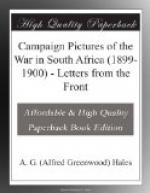The Boers have made most excellent provision for the treatment of wounded after battle. All that science can do is done. Their medical men fight as hard to save a British life or a British limb as medical men in England would battle to save life or limb of a private person. At the Bloemfontein Hospital everything is as near perfection, from a medical and surgical point, as any sane man can hope to see. It is an extensive institution. One end is set apart for the Boer wounded, the other for the British. No difference is made between the two in regard to accommodation—food, medical attendance, nursing, or visiting. Ministers of religion come and go daily—almost hourly—at both ends. Our men, when able to walk, are allowed to roam around the grounds, but, of course, are not allowed to go beyond the gates, being prisoners of war. Concerning our matron (Miss M.M. Young) and nurses, all I can say is that they are gentlewomen of the highest type, of whom any nation in the world might well be proud.
I have met one or two old friends since I came here, notably Lieutenant Bowling, of the Australian Horse, who is now able to get about, and is cheerful and jolly. Lieutenant Bowling has his right thumb shot off, and had a terribly close call for his life, a Mauser bullet going into his head alongside his right eye, and coming out just in front of the right ear. His friends need not be anxious concerning him; he is quite out of danger, and he and I have killed a few tedious hours blowing tobacco smoke skywards, and chatting about life in far off Australia. Another familiar face was that of an English private, named Charles Laxen, of the Northumberlands, who was wounded at Stormberg. I am told that he displayed excellent pluck before he was laid out, firstly by a piece of shell on the side of the head, and, later, by a Mauser bullet through the left knee. He is getting along O.K., but will never see service as a soldier again on account of the wounded leg.
I had written to the President of the Orange Free State, asking him to grant me my liberty on the ground that I was a non-combatant. Yesterday Mr. Steyn courteously sent his private secretary and carriage to the hospital with an intimation that I should be granted an interview. I was accordingly driven down to what I believe was the Stadt House. In Australia we should term it the Town Hall. The President met me, and treated me very courteously, and, after chatting over my capture and the death of my friend, he informed me that I might have my liberty as soon as I considered myself sufficiently recovered to travel. He offered me a pass via Lourenco Marques, but I pointed out that if I were sent that way I should be so far away from my work as to be practically useless to my paper. The President explained to me that it was not his wish nor the desire of his colleagues to hamper me in any way in regard to my work. “What we want more than anything else,” remarked the President, “is that




